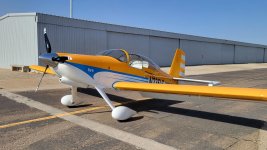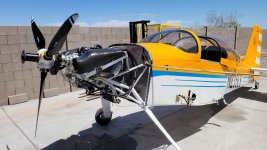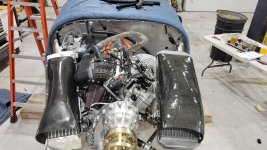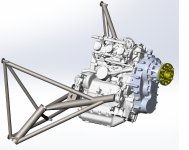Hello everyone,
I removed a Lycoming 0-235 from my RV9 and installed a Yamaha Sidewinder snowmobile engine. I know, I know I'm crazy what did you do that for....etc. The engine currently in stock tune on the fully programable ECU is set a little over 200hp from sea level to about 10kft. Currently at 15kft I can still make about 165hp according to the engine display.
It will climb out of my 1000MSL airport at over 2500FPM and at 15kft it will still climb at about 2000FPM.
Currently I can not maintain full throttle with OAT's above about 75f but I am installing a new radiator soon that should cure that.
I currently have only 7 hours of testing but the numbers are really great so far. The weight is 31lbs lighter with this engine over the 0-235 but I added the constant speed propeller. I also used the OEM cat iron exhaust manifold since I needed the weight. I pushed the engine away from firewall and used the stock turbo location which is between engine and firewall. Pushed the battery out on the engine mount and the CG ended up within .2" of the previous CG.
Biggest challenge currently is keeping the engine from overheating during Taxi but I will be adding radiator fans shortly for that.
I do not have real good fuel flow numbers yet at the lower Hp's. I know that it will burn 19GPH at wot anything under about 12kft. but that will yield a true airspeed of about 205MPH.
I am currently unhappy with the propeller blade selection for high altitude performance. It seems that there is not enough blade surface area to absorb the HP in the thinner air. Currently shopping for other options.
here is a few pictures of the install and the aircraft.
http://https://www.dropbox.com/s/oclb67lz8l3edkn/20220530_165905
.jpg?dl=0



I removed a Lycoming 0-235 from my RV9 and installed a Yamaha Sidewinder snowmobile engine. I know, I know I'm crazy what did you do that for....etc. The engine currently in stock tune on the fully programable ECU is set a little over 200hp from sea level to about 10kft. Currently at 15kft I can still make about 165hp according to the engine display.
It will climb out of my 1000MSL airport at over 2500FPM and at 15kft it will still climb at about 2000FPM.
Currently I can not maintain full throttle with OAT's above about 75f but I am installing a new radiator soon that should cure that.
I currently have only 7 hours of testing but the numbers are really great so far. The weight is 31lbs lighter with this engine over the 0-235 but I added the constant speed propeller. I also used the OEM cat iron exhaust manifold since I needed the weight. I pushed the engine away from firewall and used the stock turbo location which is between engine and firewall. Pushed the battery out on the engine mount and the CG ended up within .2" of the previous CG.
Biggest challenge currently is keeping the engine from overheating during Taxi but I will be adding radiator fans shortly for that.
I do not have real good fuel flow numbers yet at the lower Hp's. I know that it will burn 19GPH at wot anything under about 12kft. but that will yield a true airspeed of about 205MPH.
I am currently unhappy with the propeller blade selection for high altitude performance. It seems that there is not enough blade surface area to absorb the HP in the thinner air. Currently shopping for other options.
here is a few pictures of the install and the aircraft.
http://https://www.dropbox.com/s/oclb67lz8l3edkn/20220530_165905
.jpg?dl=0












